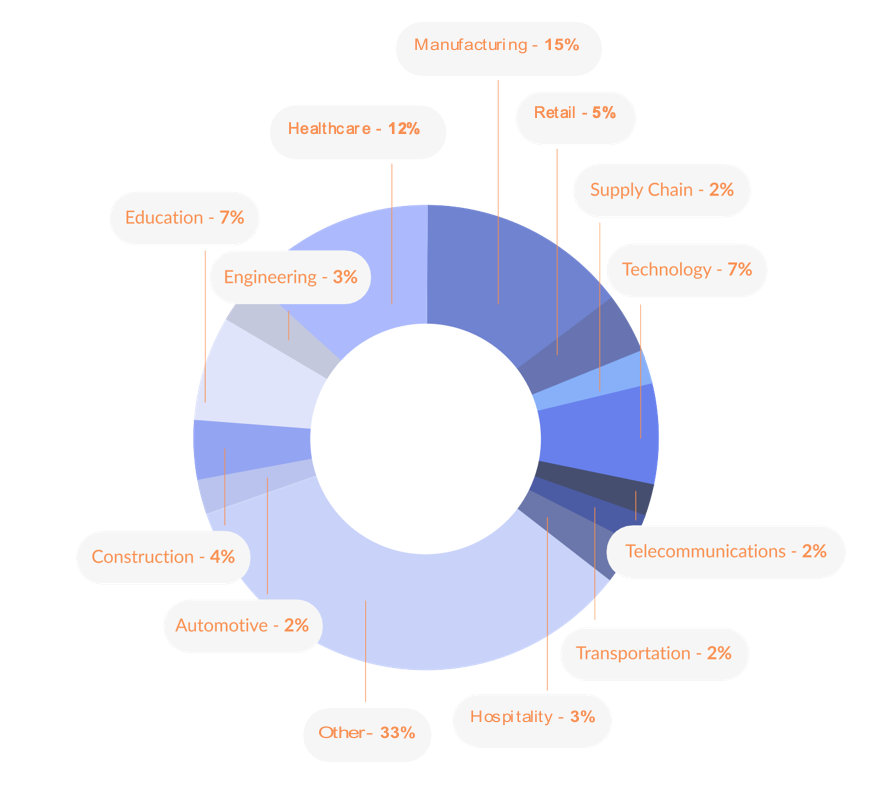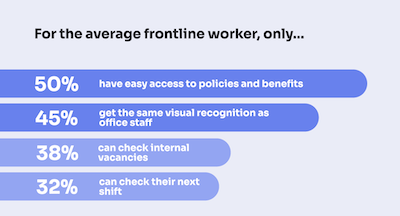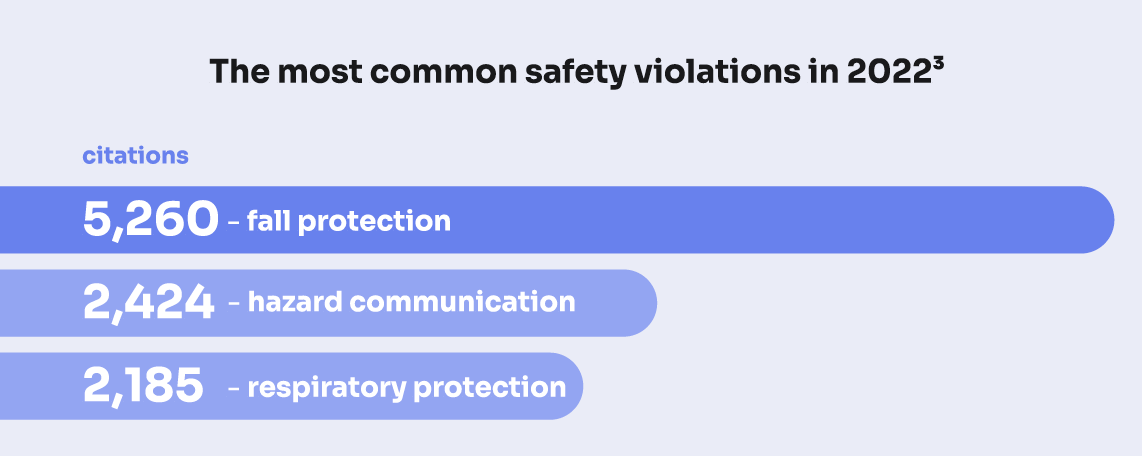How digital signage could solve the communication crater for your frontline workforce
Editor's note: Recently, ScreenCloud sent me a case study about its digital signage technology. I was intrigued and started reading the company's blog and applications for manuacturing and large organizations where frontline employee communications are laden with cracks that lead to big problems in safety, engagement, and productivity.
Instead of publishing that case study from an unrelated industry, I decided what industrial distributors could benefit more from is an excerpt fromScreenCloud's white paper about the communication breakdown epidemic across organizations with frontline workers, including distributor warehouse personnel, I determined the following white paper would make a better introduction to this interesting concept in employee communications.
The conclusion of this paper was too far down the screen, so here's a key nutshell point to consider: "The problem is that most frontline employees don't have the same access to computers, emails or company newsletters that office workers do – so your business needs to find another channel to connect with them." I leave it to you to weight whether digital signage could pay off in your distribution organization – especially if your headcount exceeds 100 and you have multiple locations.
My 2 cents – Kim Phelan, Editor, Industrial Supply magazine
***********************
The State of the Frontline Employee Experience in 2023
A white paper by ScreenCloud
Our latest research delves into the evolution of employee experience and internal communications on the frontline - and how to meet the fundamental needs of your workforce.
Dynamic communication and meaningful engagement are the foundation of every thriving business. The problem is that basic staff needs are not being met and employers are losing touch with their frontline staff.
All too often internal communications flow through the wrong channels, or get hampered by a lack of access to work laptops and devices. Over-reliance on emails, notice boards and word of mouth is still rife in industries like manufacturing, healthcare, retail and transportation, to name just a few.
For business leaders, the challenge lies in finding ways to reconnect with the rank and file who keep their business running. Modern workers already expect the same slick, personalized interactions at work as they have at home, and that means creating a 'consumerized' digital comms ecosystem to enrich their day-to-day experience.
Meanwhile, the economic landscape underlying threat of recession is pu pressure on organizations to red turnover, better attract and retain tal avoid risks and maximize producti wherever they can. Decisions made will have a huge impact on how businesses can navigate the uncertai that lies ahead.
All of this means the majority of Internal Comms, IT and Operati managers are aiming to do more with I in 2023. They need to get maximum return from their existing tech stack, while also finding creative, engaging ways to achieve a richer digital workplace experience.
This puts frontline industries at a crucial inflection point. Never before have people managers had so much responsibility for developing a stimulating culture and a communications strategy that meets the fundamental needs of employees across all levels of their organization.
The question is: are they delivering it?

The data at a glance
To find the answer, we surveyed hundreds of HR and business leaders in organizations across 11 different industries.
From this data, we've identified four major insights to create a snapshot of the state of frontline employee communication in 2023.
Insight #1
The majority of internal comms don't reach frontline employees
Only 23% of organizations we surveyed said that communications from head office reach their entire workforce.
That leaves 77% facing issues with the delivery of key messages, particularly when localized site workers are involved. There's an obvious imbalance between information employees and frontline staff, too often with the former being prioritized and the latter left in the dark.
So, why is this happening? Perhaps the biggest issue is that many organizations fail to look beyond email as their primary channel of communication. That's a problem when the majority of frontline workers either don't have a company email address or lack access to digital devices on the job.
Even when emails do hit an active inbox, it's easy for 'send all' messages to feel apathetic and stale. Instead, the medium and tone of communications should be tailored to the target audience to maximize engagement. That's the only way managers can ensure all levels of their business are always on the same page and operating as one.
Meet your audience where they are
Great communication starts by understanding who you are talking to.
 Frontline workers tend to get overlooked when HR and Internal Comms leaders focus on employee experience; though it's just as important to cater for their needs and behaviors as it is for those in head office. Access to communications, displays of recognition, value-based messaging and feedback surveys are all variables that deserve careful thinking.
Frontline workers tend to get overlooked when HR and Internal Comms leaders focus on employee experience; though it's just as important to cater for their needs and behaviors as it is for those in head office. Access to communications, displays of recognition, value-based messaging and feedback surveys are all variables that deserve careful thinking.
For instance, we know from our recent neuroscience research (conducted in partnership with University College London) that variations in content and size have different consequences for learning, memory and engagement at work. Larger screen displays - particularly HD TV screens -and focal points often capture people's attention quicker and for longer than laptop or mobile devices, which can help in the delivery of messages.
Rather than seeming prosaic and full of corporate jargon, the messages themselves should feel empathetic, human and real. And when it comes to facilitating genuine two-way communication and interactive employee experiences, the medium through which businesses choose to share and display information makes a huge difference.
The 'omnichannel' approach
Forward-thinking Internal Comms leaders don't just push out messages through multiple channels and hope for the best. They take time to understand the importance of building their internal comms strategy around employee needs and behaviors, often taking an 'omnichannel' rather than a 'multichannel' approach.
Multichannel
Different channels are spread far and wide, though they aren't necessarily connected and tend to operate independently.
Omnichannel
The channels are integrated to deliver a seamless experience with fewer targeted touchpoints and more consistent messaging.
Let's take an organization in the manufacturing industry as an example.
A multichannel approach would typically mean that workers on the factory floor can only view messages on personal devices during their lunch break, or in their own time. This creates a very small window of opportunity to inspire engagement and spread awareness of important updates.
An omnichannel approach prioritizes the channels that have the biggest impact, such as digital signage. This allows HR and communications managers to display tailored communications on screens throughout the workplace. It removes the issue of having to vie for attention with social media, or demand that staff log into an intranet or email account after they've left work for the day.
Digital signage also enables managers to seamlessly integrate and align communications across employee apps, staff training and their wider channels. In turn, this reduces digital friction, boosts information retention and makes it possible to share information with frontline staff that was previously the sole preserve of desk-based workers.
Insight #2
Frontline information workflows are falling short in many areas
Our data shows that 41% of organizations currently have glaring inefficiencies in their day-to-day frontline experience. This includes elements of rostering, internal mobility and employee reward and recognition.
By finding ways to optimize HR and Operations workflows, businesses can not only boost efficiency, cut human error and reduce costs but also relieve a lot of the burden on internal time and resources. That's a huge advantage during the current economic climate.
Remember that an omnichannel approach means placing employees at the heart of the experience and viewing things from their perspective. The trouble is that old, legacy processes and behaviors are often so ingrained that businesses miss the quick wins right in front of them. Channels like digital signage often go untapped, when in fact they are one of the best ways to capture the attention of frontline workers.
Looking at the data below, it's clear plenty of organizations still have some way to go.
For the average frontline worker, only ...

The power of automation
The idea of 'doing more with less' is a hurdle facing most industries in the post-pandemic world.
That's why modern HR and IT leaders are turning to technology that can automate and scale manual or time consuming tasks; and realize ROI - fast.
The stakes are higher than ever, particularly for businesses that are facing periods of change management. Getting your internal communications mix right is crucial to navigate complexity and maintain a positive employer brand during these times.
Even so, many companies are still reliant on paper, manual admin and word of mouth to get their internal updates across to frontline workers, especially within industries like manufacturing, healthcare and retail. Notice boards constantly need to be refreshed and new timetables printed, with the risk of human error looming all the while.
By automating key workforce management processes, it's no exaggeration to say staff would save hundreds of hours every year. All that time could then be reinvested into creating more meaningful and empathetic content that does a better job at engaging its target audience.
Automation can save up to 90% of the time HR spends on repetitive admin tasks.
'Source: Guidebook Zenefits, Nucleus Research
BASF: The frontline experience in action
BASF Group is the largest chemical manufacturer in the world. The company employs 17,000 staff across over 100 sites in the US alone, the majority of which are frontline workers.
For many years its communications team relied on an aging system that required a lot of heavy lifting from the corporate side. Typically, it had been a laborious task to send out important, on brand updates at both local and corporate level - and even then, they weren't hitting high levels of engagement with frontline staff.
Given its existing supply of screens, BASF spotted digital signage as an ideal avenue to better connect with workers and settled on Screencloud as its perfect partner after a lengthy procurement process. With the new system in place, the team has access to a far more efficient, automated system that makes it easy for managers to quickly push out key messages when needed. Read the full case study here
Insight #3
Health and safety communication needs to evolve
Just 24% of businesses strongly agreed that health and safety compliance communication is straightforward to deliver.
 Safety incidents and instances of non-compliance can devastate the lives of workers and their families, but they're also damaging to a company's bottom line. Every year, U.S. businesses lose billions of dollars as a result of lost productivity, medical fees, and employee compensation.
Safety incidents and instances of non-compliance can devastate the lives of workers and their families, but they're also damaging to a company's bottom line. Every year, U.S. businesses lose billions of dollars as a result of lost productivity, medical fees, and employee compensation.
Too many organizations rely on 'one and done' approaches to health and safety training, and don't give their staff enough opportunities to recap important details and specific guidance related to their role. Even today, plenty of industry sites lack engaging visual reminders that hammer home the importance of safety awareness.
Employers need to remember that even the best health and emergency protocols and policies are useless if key messages aren't being communicated on a regular basis.
Addressing hot spots
Poor health and safety communication is a real concern given the pressure employers face to evidence practical steps taken to reduce risks and keep staff up to date with the latest best practices.
The challenge becomes greater when you consider that the most frequent safety violations take place in industries involving frontline staff. It's worth noting that hazard communication ranked as the second most common violation in 2022, which tallies with our own findings on the lack of compliance communications.
The most common safety violations in 20223

Where is your safety culture lacking?
Every organization has its own safety challenges. Those with a largely frontline demographic tend to face one or more of the following pain points; which would your business consider a priority?
Emergency notifications
Wayfinding and safety instructions
Compliance reminders
On-the-spot training and tips D Awareness of workplace hazards D Response to hazards
Most of these challenges stem from scenarios in which businesses struggle to get the right messages in front of the right people and at the right time. Placing digital signs in strategic spots can help ensure health and safety messages are reaching the people who need it most.
Our behavioral research study with Durham University found that regular visible 'nudges' can prove highly effective at influencing employee behavior and enhancing memory recall. This makes a big difference for frontline workers who aren't sitting at a desk with a computer all day and don't have access to other communication tools.
Insight #4
HR and Comms teams aren't tracking ROI
83% of organizations we surveyed don't have an effective way to measure the success of their internal communications strategy.
This puts them at a huge disadvantage when validating the direction of long term plans and investments - and it definitely doesn't help them gain a stronger voice in the boardroom.
More often than not, departments simply don't know where to start. Every business is different, but the first step is usually the same: clearly define your objectives. It could be to improve engagement, productivity, retention, health and safety or any other key metrics related to your people function.
Looking at the stats below, it's surprising that less than half of businesses run regular employee surveys to track key metrics around internal comms as this can be a great way to gauge employee sentiment.
How do businesses measure the impact of internal communications?
Setting the baseline
With a set of clear objectives in mind, the next step for HR is to gather the employee data points they already have available, such as turnover rates, safety incidents, eNPS scores and stats around productivity.
They can then draft ideas for the type of information they'd like to track that aligns with their wider business goals and values. Running a company-wide survey is a great way to set baseline metrics across your defined KPls. This can then be repeated on a regular basis to compare and contrast insights and trends, and see what impact certain initiatives have made.
Digital signage also offers an engaging way to encourage as many employees as possible to submit their feedback. QR codes linking to feedback surveys can be displayed in strategic places throughout the workplace, making it easy for members of staff to scan the code on their phone or mobile device and complete the questions.
The value of digital signage
Recent research from Axios shows that the cost of ineffective communication is equal to over $15,000 per employee every year.5
The total cost quickly adds up when you extrapolate that across a workforce of 500 or 5,000 people. We've designed this useful calculator so you can get a quick estimate of the level of engagement gains you're potentially missing out on, as well as a ballpark cost for turning digital signage into a key comms channel for frontline workers.
Remember that engagement feeds straight back into company performance. A study from Gallup found that companies with top-quartile engagement scores recorded 70% fewer safety incidents than bottom-quartile businesses, and 21% higher profits.6
Need a direct line to your frontline staff?
A superb comms strategy pinpoints the most efficient ways to tether employee needs and organizational values together. The problem is that most frontline employees don't have the same access to computers, emails or company newsletters that office workers do – so your business needs to find another channel to connect with them.
ScreenCloud's digital signage solution ensures you get the right information in front of the right people at the right time. Our user friendly platform enables you to automate content workflows and broadcast any type of content to targeted locations across your business.
Best of all, it's simple to scale and integrate with your existing systems, making it easy for IT to implement and HR to manage.













